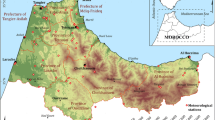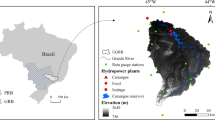Abstract
This study presents a multitemporal climatology of water excess and shortage during the 20th century in the La Plata Basin. The climatology is based on 0.5o × 0.5o grid across the region. We transform monthly precipitation series for each point into index series at different time scales using the Standardized Precipitation Index (SPI). A month is under water excess (shortage) conditions at different time scales (i = 6, 9, 12, and 18 months), when SPI[i](j) > 1.5 (SPI[i](j) < 1.5), where j is the current month. Trends in precipitation were determined using mean regional series of average values over the entire basin. A month when more than 30% of the total basin is under water excesses (shortages) is defined as an excess (shortage) critical month. From the vulnerability point of view, we analyzed the occurrence of critical months. The number of excess critical months increase with time scale of index, and almost all the critical months occurred after 1950 as a consequence of the low-frequency precipitation pattern. That means a noticeable increase in the vulnerability to extended excesses (more than 30% of the area under water excesses) after 1950, especially over the Upper Paraná and the Uruguay basins. For shortage critical months, the behavior depends on time scales. At large time scale (18 and 12 months), almost all the shortage critical months occurred in the period 1901–1950 and only at shorter time scale (9 and 6 months), some critical months appeared after 1950. That means a noteworthy decrease in the basin vulnerability to extended water shortage after 1950 and a moderate decrease in vulnerability to generalized shortage. If we analyze the frequency and mean duration of water excess and shortage events across the basin, we can appreciate that there is a tendency to relate higher frequency regions with regions with lower mean duration events, and conversely.










Similar content being viewed by others
References
Abramowitz M, Stegun I (1965) Handbook of mathematical functions with formulas, graphs and mathematical tables. Dover Publications Inc, New York
Allen MR, Smith LA (1996) Monte Carlo SSA: detecting irregular oscillations in the presence of colored noise. J Climate 9:3373–3404
Anderson RJ, da Franca Ribeiro dos Santos N, Diaz HF (1993) An analysis of flooding in the Paraná/Paraguay River Basin. LATEN Dissemination Note #5, The World Bank. Latin America & the Caribbean Technical Department, Environment Division
American Meteorological Society (1997) Policy statement—meteorological drought. Bull Amer Meteor Soc 78:847–849
Barros V, Silvestri G (2002) The relation between sea surface temperature at subtropical south-central Pacific and precipitation in Southeastern South America. J Clim 15:251–267
Barros V, Doyle M, González M, Camilloni I, Bejarán R, Caffera RM (2002) Climate variability over subtropical South America and the South America monsoon: a review. Meteorológica 27(1–2):33–57
Barros VR, Doyle ME, Camilloni IA (2008) Precipitation trends in southeastern South America: relationship with ENSO phases and with low-level circulation. Theor Appl Climatol 93:19–33
Berbery EH, Barros VR (2002) The hydrological cycle of the La Plata basin in South America. J Hydrometeor 3:630–645
Berbery HE, Doyle M, Barros V (2006) Regional precipitation trends. In: Barros V, Clarke R, Silva Diaz P (eds) Climate Change in the La Plata Basin. CONICET, Buenos Aires, pp 67–79
Camilloni IA, Barros VR (2003) Extreme discharge events in the Paraná River and their climate forcing. J Hydrol 278:94–106
Castañeda ME, Barros VR (1994) Las tendencias de la precipitación en el Cono Sur de América al este de los Andes. Meteorológica 19:23–32
Castañeda ME, Barros VR (2001) Tendencias de la precipitación en el oeste de Argentina. Meteorológica 26:5–23
Conway D, Jones PD, García NO, Vargas WM (1999) Assessing the impact of future climatic change on the water resources and the hydrology of the Río de La Plata basin, Argentina. Final report of work under contract ARG/B7-3011/94/25a. Commission of the European Communities. Buenos Aires, Argentina
Diaz AF, Studzinski CD, Mechoso CR (1998) Relationship between precipitation anomalies in Uruguay and southern Brazil and Sea Surface Temperature in the Pacific and Atlantic Oceans. J Climate 11:251–271
Doyle E, Barros VR (2002) Midsummer low-level circulation and precipitation in subtropical South America and related sea surface temperature anomalies in the South Atlantic. J Climate 15:3394–3410
Dracup JA, Lee KS, Paulson EG (1980) On the definition of droughts. Water Resour Res 16:297–302
Edwards DC, McKee TB (1997) Characteristics of 20th century drought in the United States at multiple timescales. Colorado State University, Fort Collins. Climatology Report No. 97-2, pp 155
Essenwanger O (1976) Applied statistics in atmospheric science. Part A. Frequencies and curve fitting. Elsevier Scientific Publishing Company, Amsterdam
Garcia NO, Vargas WM (1996) The spatial variability of runoff and precipitation in the Río de la Plata Basin. J Hydro Sci 41:279–299
Garcia NO, Vargas WM (1998) The temporal climatic variability in the Rio de la Plata Basin displayed by the river discharges. Climatic Changes 38:359–379
Ghill M, Vautard R (1991) Interdecadal oscillation and the warming trend in global temperature time series. Nature 359:324–327
Giorgi F (2002) Variability and trends of sub-continental scale Surface Climate in the twentieth century. Part I: observations. Clim Dyn 18:675–691
Grimm AM, Ferraz SET, Gomes J (1998) Precipitation anomalies in Southern Brazil associated with El Niño and La Niña events. J Climate 11:2863–2880
Grimm AM, Barros V, Doyle M (2000) Climate variability in Southern South America associated with El Niño and La Niña events. J Climate 13:35–58
Guttman NB (1999) Accepting the standardized precipitation index: a calculation algorithm. J Am Water Resour Assoc 35:311–322
Hayes MJ, Svoboda MD, Wilhite DA, Vanyarkho OV (1999) Monitoring the 1996 drought using the standardized precipitation index. Bull Amer Meteor Soc 80:429–438
Heim RR Jr (2002) A review of twentieth-century drought indices used in the Unites States. Bull Amer Meteor Soc 83:1149–1165
Hulme M (1994) Validation of large-scale precipitation fields in global circulation models. In: Desbois M, Desalmand F (eds) Global precipitation and climate change. NATO ASI Series I, Vol. 26. Springer-Verlag, Berlin, pp 387–406
Keyantash J, Dracup J (2002) The quantification of drought: an evaluation of drought indices. Bull Amer Meteor Soc 83:1167–1180
Krepper CM, Garcia NO (2004) Spatial and temporal structures of trends and interannual variability of precipitation over the La Plata Basin. Quarterly International 114:11–21
Krepper CM, Sequeira ME (1998) Low-frequency variability of rainfall in Southeastern South America. Theor Appl Climatol 61:19–28
Krepper CM, Garcia NO, Jones PD (2003) Interannual variability in the Uruguay river basin. Int J Clim 23:1103–1115
Krepper CM, Garcia NO, Jones PD (2008) Low-frequency response of the Upper Paraná basin. Int J Climatol 28:351–360
Labraga JC, Frumento O, López M (2000) The atmospheric water vapor cycle in South America and the tropospheric circulation. J Climate 13:1899–1915
Lenters JD, Cook KH (1995) Simulation and diagnosis of the regional summertime precipitation climatology of South America. J Climate 8:2988–3005
Liebmann B, Vera C, Carvalho LMV, Camilloni IA, Hoerling MP, Allured D, Barros VR, Báez J, Bidegain M (2004) An observed trend in central South America precipitation. J Climate 17:4357–4367
Lloyd-Huges B, Saunders MA (2002) A drought climatology for Europe. Int J Clim 22:1571–1592
McKee TB, Doesken NJ, Kleist J (1993) The relation of drought frequency and duration to time scales. Proceeding of the Eight Conference on Applied Climatology. 17–22 January, Anaheim, California. Amer Meteor Soc. Boston, Massachusetts, pp 179–184
McKee TB, Doesken NJ, Kleist J (1995) Drought monitoring with multiple time scales. Proceeding of the Ninth Conference on Applied Climatology. 15–20 January, Dallas, Texas. Amer Meteor Soc. Boston, Massachusetts, pp 233–236
Minetti JL, Vargas WM (1998) Trends and jump in the annual precipitation in South America, south of the 15°S. Atmósfera 11:205–221
Minetti JL, Vargas WM, Poblete AG, Acuña LR, Casagrande G (2003) Non-linear trends and low-frequency oscillations in annual precipitation over Argentina and Chile, 1931–1999. Atmósfera 16:119–135
Mitchell TD, Jones PD (2005) An improved method of constructing a database of monthly climate observations and associated high-resolution grids. Int J Clim 25:693–712
Mitchell TD, Carter TR, Jones PD, Hulme M, New M (2004) A comprehensive set of high-resolution grids of monthly climate for Europe and the globe: the observed record (1921–2000) and 16 scenarios (2001–2010). Tyndal Centre Working Paper 55:25
New M, Hulme M, Jones PD (2000) Representing twentieth century space–time climate variability. Part 2: Development of 1901–96 monthly grids of terrestrial surface climate. J Climate 113:2217–2238
Nicolini M, Saulo AC, Torres JC, Saulo P (2002) Enhance precipitation over southeastern South America related to strong low-level jet events during austral warm season. Meteorológica 27:59–69
Nogués-Paegle JN, Mo KC (1997) Alternating wet and dry conditions over South America during summer. Mon Wea Rev 3:279–191
Nogues-Paegle J, Vera C (2009) South American precipitation regimes. IX International Conference on Southern Hemisphere Meteorology and Oceanography. 9 to 13 February 2009. Melbourne, Australia. http://www.bom.gov.au/events/9icshmo/manuscripts/TH0830_Paegle.pdf. Accessed July 2009
Plaut G, Vautard R (1994) Spells of low-frequency oscillation and weather regimes in the Northern Hemisphere. J Atmos Sci 51:210–236
Pisciottano G, Diaz A, Cazes G, Mechoso CR (1994) El Niño-Southern Oscillation Impact on Rainfall in Uruguay. J Climate 7:1286–1302
Salio PV, Nicolini M, Saulo C (2002) Chaco low-level jet characterization during the austral summer season by ERA reanalysis. JGR-Atmospheres 107. doi:10.1029/2001JD001315
Scian B, Labraga JC, Reimers W, Frumento O (2006) Characteristics of large-scale atmospheric circulation related to extreme monthly rainfall anomalies in the Pampa region, Argentina, under non-ENSO conditions. Theor Appl Climatol 85:89–106
Thom HCS (1958) A note on the gamma distribution. Mon Wea Rev 86:117–122
Tucci CEM (2001) Some scientific challenges in the development of South America’s water resources. J Hydrol Sci 46:1–10
Tucci CEM, Clarke RT (1998) Environmental issues in the La Plata basin. Int J Water Resour Dev 14:157–173
UNESCO-WWAP (United Nations Educational, Scientific and Cultural Organization-World Water Assessment Program) 2007.The La Plata basin case study (Final Report), pp 516. http://www.unesco.org/water/wwap/case_studies/la_plata/151252e_rev.pdf Accessed in 2007
Vautard R (1995) Patterns in time: SSA and MSSA. In: von Storch H, Navarra A (eds) Chapter 14 of analysis of climate variability: applications of statistical techniques. Springer Verlag, Berlin, p 327
Vautard R, Ghill M (1989) Singular spectrum analysis in non-linear dynamics with applications to paleoclimatic time series. Physica D 35:395–424
Vera C, Higgins W, Amador J, Ambrizzi T, Garreaud R, Gochis D, Gutzler D, Lettenmaier D, Marengo J, Mechoso CR, Nogues-Paegle J, Silva Dias PL, Zhang C (2006) Toward a unified view of the American monsoon systems. J Climate 19:4977–5000
Wu H, Hayes MJ, Weiss A, Hu Q (2001) An evaluation of the standardized precipitation index, the China-Z and the statistical Z-score. Int J Clim 21:745–758
Zhou J, Lau KM (1998) Does a monsoon climate exist over South America? J Climate 11:1020–1040
Author information
Authors and Affiliations
Corresponding author
Rights and permissions
About this article
Cite this article
Krepper, C.M., Zucarelli, G.V. Climatology of water excesses and shortages in the La Plata Basin. Theor Appl Climatol 102, 13–27 (2010). https://doi.org/10.1007/s00704-009-0234-6
Received:
Accepted:
Published:
Issue Date:
DOI: https://doi.org/10.1007/s00704-009-0234-6




